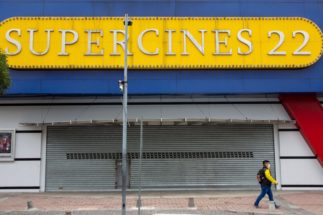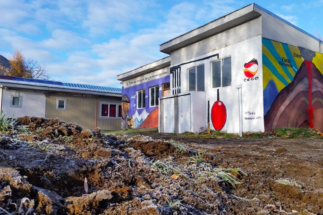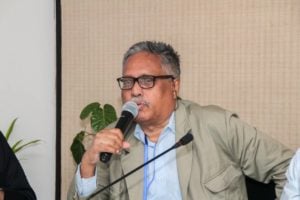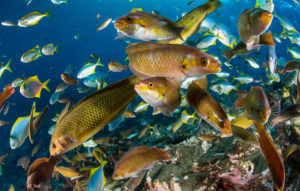When the Covid-19 pandemic arrived in Peru in March 2020, it hit the city of Lima first. The virus seemed far from the Amazon, a region that seriously lacks public services and where many indigenous communities live in inaccessible areas.
However, even in the capital, the virus quickly affected the Amazon community that inhabits the Cantagallo neighbourhood, near the city centre. It is a settlement with precarious houses, without water and sanitation services, inhabited mainly by Shipibo-Konibo migrants from the Ucayali region.
Many are artisans and their income depends on what they can sell each day, so when quarantine was declared on March 15, it was difficult for them to cover their expenses. When the first death was reported in the neighbourhood, the police established a cordon, making access to water, food and health services even more difficult.
News of people killed by Covid-19 in Cantagallo quickly reached the Amazon city of Pucallpa, capital of Ucayali, on the other side of the Andes. There is a relatively large Shipibo Konibo community there.
Although the virus had not yet reached Pucallpa, Shimpukat Soria, an artist better known by his stage name, Shimpu, heard that a fellow artist in Cantagallo had fallen ill and died from Covid-19. Knowing that people there were already in quarantine, with no possibility of going out to seek remedies, he got to work.
He and other Shipibo youths from Pucallpa collected leaves from a shrub known as matico, which has long been used by his people to treat wounds and reduce inflammation. They sent a shipment to Cantagallo, which by then was isolated because the spread of infections.
Affected indigenous communities
Latin America has had some of the highest rates of Covid-19 infections and deaths in the world, but the pandemic has been especially devastating among Amazonian indigenous communities. Scattered along rivers, with little access to clean water and sanitation, and often without even basic health centers, these communities rely heavily on traditional medicine.
By December 2020, more than 73,000 cases had been reported among indigenous peoples in the Amazon regions of the nine countries that share the basin, and more than 2,100 had died, according to reports compiled by the Catholic Church and the Coordinator of Indigenous Organizations of the Amazon Basin (COICA).
The actual number is probably higher since many cases and deaths are not reported, says Gregorio Díaz, one of the COICA coordinators. In fact, indigenous peoples are largely invisible in national statistics. Only well into the first wave of the pandemic did Peru begin to take note of patients’ ethnic origin.
For indigenous peoples, the loss is severe. The virus tends to be most deadly in people aged over 50 and threatens to take a disproportionate toll on indigenous elders.
Ilda Ahuanari died on May 10 in the port of Nauta, on the Marañón River, 100 kilometres from Iquitos at the end of the only paved highway in the Loreto region. She was 78. Ahuanari, a Kukama woman, helped revive interest in the Kukama language in Nauta and neighboring towns after the younger generation had stopped using it.
Shimpukat believes that the only way to deal with the coronavirus in indigenous communities is to combine traditional practices with Western medicine. Health experts, including those at the Pan American Health Organization (PAHO), agree, but the idea has been slow to take hold.
A quick but drastic reaction
Covid-19 caught Peru off guard. However, the government reacted quickly and drastically. The first confirmed case was reported on March 6 and a few days later, on March 15, the then president Martín Vizcarra announced total lockdown, confining all except essential workers to their homes.
But this had unintended consequences. About 70% of Peruvian workers are employed in the informal economy and often earn just enough in one day to survive it. When their meagre savings ran out, and government help was slow to arrive, they were forced to go out and look for work, violating lockdown regulations.
Such was the case in Iquitos, the largest Amazon city in Peru and the largest urban area in the Amazon that is not accessible by road. By the time the government had declared a national lockdown, the coronavirus was probably already quietly spreading through crowded slums adjacent to ports and around city limits.
The Regional Health Directorate was caught unprepared and hastily responded, reserving the regional public hospital for Covid-19 patients. However, that hospital and other health centres were understaffed even before the pandemic, and the region soon began operating with around half the usual number of doctors.
In a few weeks, the hospital was overwhelmed. Corridors and waiting rooms were turned into makeshift wards. When there were no beds left, patients lay on mats on the floor, each attached by a flexible tube to an oxygen cylinder. Some people reported that the bodies wrapped in sheets piled up faster than they could be removed.
Then Iquitos ran out of oxygen. The hospital’s oxygen generating plant was only partially operational when the pandemic struck, and demand quickly exceeded capacity. Desperate relatives of critically ill patients queued for hours in front of the city’s two private generating plants.

True to the law of supply and demand, the price of an oxygen cylinder that would have cost about US$150 in January had skyrocketed to $1,000 by May. Essential medicines, also in short supply, became prohibitively expensive.
Strangely, the official case count increased little and the death toll remained stable for days at around 90. However, those figures were an illusion. In part, the low case count was due to a lack of test kits: only cases that tested positive were officially counted, and with kits in short supply and time of the essence, doctors treated anyone with symptoms as if they were a patient of Covid-19.
The low death toll had another explanation: all but one of the members of the hospital’s Epidemiology Unit were ill with the virus, so there were no staff to update the records.
Organised indigenous communities
Left to their own devices, the indigenous communities organised. In some communities, families left their homes and went into the forest, building shelters where they hoped to overcome the pandemic with food that they hunted, fished or cultivated in small gardens.
Other communities tried to close themselves off from outsiders, but that proved difficult as family members who had migrated to the cities sought to return home when money and food were scarce
Traditional medicine is not a pill. It is a way of treating oneself integrally, where herbs are another element of the worldview
The pandemic took longer to reach Pucallpa, even though the city has a land link with the densely populated Peruvian coast. But authorities did not use that time to learn from the Iquitos experience and prepare for a wave of patients, and the Pucallpa hospital was soon overwhelmed too.
Many indigenous people were reluctant to go to the hospital, so Shimpukat and the other young people who had sent matico leaves to Cantagallo also organised. They began promoting traditional remedies, not only matico leaves, but also ginger, onion, garlic and eucalyptus for those fighting the disease at home. A Catholic parish lent them space to set up a shelter.
Members of the organisation use a combination of traditional medicine and Western medicine, treating symptoms in an attempt to prevent people becoming hospitalised.
Luis Gutiérrez Alberoni, a pediatrician specialising in intercultural health who has worked in with PAHO said: “Traditional medicine is not a pill. It is a way of treating oneself integrally, where herbs are another element of the worldview. “
Even in cities like Iquitos and Pucallpa, indigenous people seek traditional medicine first and consider Western medicine to be complementary, Gutiérrez adds.
In his view, closing the gap between the two requires dialogue. Western medical professionals and health authorities, in particular, must listen to and learn from healers and members of indigenous communities in order to bridge the gap between the two forms of healthcare.
After the first wave of the pandemic, the healthcare shelter for the indigenous groups was momentarily empty. However, by mid-December of last year, he was back with patients, which for Shumpukat could herald a second wave of infections.
Indeed, since January, the number of infections in Peru has increased dramatically, reaching August’s death rate in just six weeks.
The figures in the jungle are correspondingly high. In Loreto, the incidence of Covid-19 cases rose from 6 to 60 per 100,000 inhabitants in the month of January. Again, there is a sense of desperation due to the shortage of medical oxygen.
Shipukat argues: “What we are looking for is support, that we are considered a fundamental part of the Regional Health Directorate, and that they include us as traditional doctors, to continue our work.”
This publication is part of a journalistic project led by Periodistas por el Planeta (PxP) in Latin America. Creative Commons License.








![Indian father riding on at electric three wheeler with his child [image: Suman Kumar / Alamy]](https://dialogue.earth/content/uploads/2021/05/2BHEFB6-300x200.jpg)